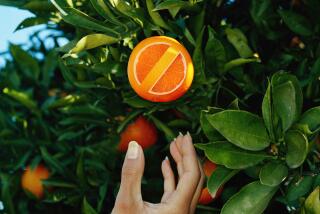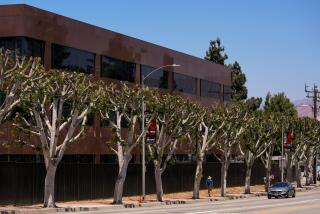GARDENING : Pruning Should Beautify, Not Maim, Trees
- Share via
Pruning done well is a craft that enhances a tree’s natural beauty by removing deadwood and crisscrossing branches. But pruning done poorly is anything but craftsmanship, say Orange County tree experts.
They call it butchery.
You’ve seen the trees they’re talking about--the ones that have been topped and reduced to little more than tall poles with a few stubs.
“I consider pruning a real art,” says Rico Montenegro, assistant director of the Fullerton Arboretum. An expert “looks at a tree and visualizes what its characteristics should be and then prunes only for the purpose of trying to enhance that shape and to take anything out that might disfigure that shape.”
Pruning is often necessary for evergreens and non-fruit-bearing, deciduous trees common to Southern California. These trees may need pruning for safety reasons or aesthetics, to remove dead growth or, in some instances, to control growth.
Although topping is not necessary to achieve any of these goals, trees often receive what is called “severe heading back,” “stubbing” or “dehorning”--the removal of a tree’s major branch structure.
Topping not only looks bad, but also harms trees.
Because topping alters a tree’s natural growth characteristics, such a procedure forces an unnatural growth habit on a tree, increasing the risk of weak branches, limb breakage, decay and disease, says Bruce Wegner, a landscape architect and manager of Parks and Recreation for San Clemente.
“When you beanpole a eucalyptus to no growth at all, you’re asking for diseases to enter the tree, like the Australian borer,” also known as the eucalyptus longhorned beetle, says Jeff Peterson of Peterson’s Tree Works in Orange.
Topping also alters a tree’s ability to manufacture nutrients for itself. Older trees can die from the trauma of topping, Wegner says.
“In pruning a tree, approximately only one-third of the foliage should be removed at any given time,” says Samuel Knapp, a consulting arborist and founder of Knapp Associates, a tree maintenance firm with certified arborists on staff and offices in Fullerton and Riverside.
(An arborist is a tree specialist who has passed a peer review to become a member of the American Society of Consulting Arborists.)
Knapp says one reason to limit pruning is to prevent large tree wounds. Pruning wounds should be less than 2 inches in diameter to avoid causing decay.
Trees can cover their wounds, he says, but never really “heal” them.
So, why are topping and poor pruning so common?
“The reason a lot of this butchering takes place is that we have trees or plants that are planted inappropriately for a given site,” Montenegro says. “Maybe somebody wanted a tree that was only going to be 20 or 30 feet tall and they have planted a tree that (at maturity) reaches 60 or 80 feet tall. So oftentimes (they) cut back or butcher that tree.”
Poor tree selection is a major problem, Wegner agrees. And part of that is people’s misunderstanding and use of the terms “small” and “large” trees.
The average person, he says, thinks of a 15- to 20-foot tree as large. But it’s not.
To a nursery worker or an arborist, that’s a small tree. A medium tree is one that grows 25 to 40 feet, Wegner says, and a large one is more than 40 feet.
“The worst thing you can do is put the wrong tree in the wrong spot,” he says.
Unfortunately, he says, that’s a common problem because people buy a tree in a 5-gallon container without realizing that in 10 years it will overgrow its spot.
When a tree is much too large for its site, it is often best to uproot and replace it with a smaller tree. That may be expensive, but it’s better than brutally pruning the tree every year or two, which becomes necessary after the initial topping, to control the problems that have been created.
“I see many examples of this happening where trees have been severely pruned in the past and they have all this growth that’s come out. . . . Branches are breaking. Branches are falling,” Montenegro says.
“So what has happened is that these so-called tree trimmers now have gotten themselves a permanent job,” he says. “They need to come back on a yearly basis or every other year, (to) hack away at those poor trees to try to keep them in bounds.”
Knapp says that having a tree pruned by an arborist is likely to cost 20% to 30% more than having it done by a less knowledgeable tree trimmer. But the tree owner saves money in the long run because the tree will be healthier and should not need to be pruned as often.
This idea of selective tree pruning has been gaining wider acceptance in the tree-trimming industry over the past five years, partly because of the work of Alex Shigo, a U.S. Forest Service researcher.
Shigo, who is retired from the Forest Service and lives in New Hampshire, found that it’s more important to focus on what keeps a tree healthy, rather than what makes trees sick.
“As a result of his findings, there’s now a new understanding, that people--at least people who are professional and who are actually qualified to be doing tree work--don’t top trees,” says Pat Mahoney, president of West Coast Arborists Inc. in Buena Park.
Some people think tall trees need to be topped for safety reasons. But Knapp disagrees, saying, “The height of a tree does not make the tree dangerous.”
A factor that needs to be considered, he says, is whether a tree’s roots are healthy and strong. If they are, the tree shouldn’t tip over in a wind.
Another consideration is a tree’s wind-sail factor. If a tree has a dense canopy, wind is more likely to cause damage, because of resistance to the wind. In this instance, foliage acts much like a sail on a ship.
Knapp says a tree should be thinned so that you can see 25% to 40% daylight through a large tree’s canopy and 10% to 25% for a small tree. This allows wind to pass through the tree and there is less chance of breakage.
Thinning out a tree canopy also enhances a view much more effectively than topping it.
“What you can do is thin out the trees and try to create pockets of views through the trees, which, in my opinion, actually is more of a benefit than having a wide-open view of the entire area that’s barren,” Wegner says.
As with most things, however, there are some exceptions to the rule of gentle pruning.
Storm damage or some diseases may require severe pruning to save a tree, Wegner says. But it’s important to remember that a tree pruned in such a way will then need intensive maintenance to bring it back to health.
Reviving and restoring a tree that has been topped is possible, the experts say, but it depends on the how severely and how often the tree was pruned.
If a tree is young enough, there is potential to correct the damage, Wegner says, by corrective trimming and careful treatment. But the tree will never be as strong as if it were planted and trimmed properly.






